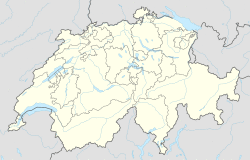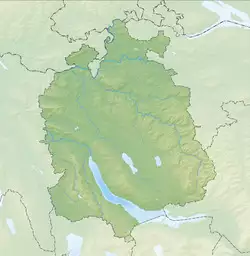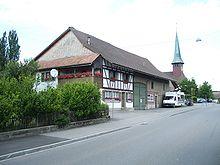Niederhasli | |
|---|---|
Municipality in Switzerland | |
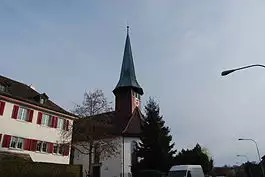 | |
Location of Niederhasli 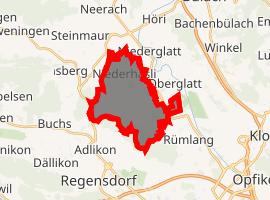 | |
| Coordinates: 47°29′N 8°29′E / 47.483°N 8.483°E | |
| Country | Switzerland |
| Canton | Zurich |
| District | Dielsdorf |
| Area | |
| • Total | 11.24 km2 (4.34 sq mi) |
| Elevation | 418 m (1,371 ft) |
| Population (2018-12-31)[2] | |
| • Total | 9,264 |
| • Density | 820/km2 (2,100/sq mi) |
| Time zone | UTC+01:00 (Central European Time) |
| • Summer (DST) | UTC+02:00 (Central European Summer Time) |
| Postal code(s) | 8155 |
| SFOS number | 0090 |
| Surrounded by | Buchs, Dielsdorf, Niederglatt, Oberglatt, Regensdorf, Rümlang, Steinmaur |
| Website | www SFSO statistics |
Niederhasli is a municipality in the district of Dielsdorf in the canton of Zürich in Switzerland.
History
Niederhasli is first mentioned in 931 as Hasila.[3]
On 10 January 2000, Crossair Flight 498 crashed in Niederhasli after taking off from Zurich Airport, killing all 10 people on board. The accident was caused by pilot error which lead to loss of control of the aircraft.[4]
Geography
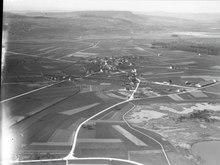
Niederhasli has an area of 11.3 km2 (4.4 sq mi). Of this area, 58.3% is used for agricultural purposes, while 21.5% is forested. Of the rest of the land, 18.7% is settled (buildings or roads) and the remainder (1.5%) is non-productive (rivers, glaciers or mountains).[5]
The municipality is located in the lower Glatttal near the entrance to the Wehntal. It includes the villages of Niederhasli, Oberhasli, Mettmenhasli and Nassenwil. Before 1840 it also included the village of Niederglatt, which became an independent municipality at that time.
Demographics
Niederhasli has a population (as of 31 December 2019) of 9,345.[6] As of 2007, 22.6% of the population was made up of foreign nationals. Over the last 10 years the population has grown at a rate of 18.9%. Most of the population (as of 2000) speaks German (83.9%), with Italian being second most common ( 4.7%) and Albanian being third ( 2.4%).
In the 2007 election the most popular party was the SVP which received 43.8% of the vote. The next three most popular parties were the SPS (15.4%), the CVP (11.9%) and the FDP (9.5%).
The age distribution of the population (as of 2000) is children and teenagers (0–19 years old) make up 25.9% of the population, while adults (20–64 years old) make up 66.9% and seniors (over 64 years old) make up 7.2%. In Niederhasli about 75.8% of the population (between age 25-64) have completed either non-mandatory upper secondary education or additional higher education (either university or a Fachhochschule).
Niederhasli has an unemployment rate of 2.82%. As of 2005, there were 85 people employed in the primary economic sector and about 36 businesses involved in this sector. 573 people are employed in the secondary sector and there are 59 businesses in this sector. 1016 people are employed in the tertiary sector, with 186 businesses in this sector.[5]
The historical population is given in the following table:[3]
| year | population |
|---|---|
| 1634 | 502 |
| 1850 | 1,046 |
| 1900 | 876 |
| 1950 | 1,072 |
| 1980 | 5,057 |
| 2000 | 7,589 |
Transport
Niederhasli railway station is a stop of the Zürich S-Bahn on the line S15. It is a 20-minute ride from Zürich Hauptbahnhof.
References
- ^ a b "Arealstatistik Standard - Gemeinden nach 4 Hauptbereichen". Federal Statistical Office. Retrieved 13 January 2019.
- ^ "Ständige Wohnbevölkerung nach Staatsangehörigkeitskategorie Geschlecht und Gemeinde; Provisorische Jahresergebnisse; 2018". Federal Statistical Office. 9 April 2019. Retrieved 11 April 2019.
- ^ a b Niederhasli in German, French and Italian in the online Historical Dictionary of Switzerland.
- ^ "Investigation Report of the Aircraft Accident Investigation Bureau on the accident to the Saab 340B aircraft, registration HB-AKK of Crossair Flight LX498 on 10 January 2000 near Nassenwil/ZH" (PDF). Aircraft Accident Investigation Bureau. 21 October 2002. Archived (PDF) from the original on 14 April 2008. Retrieved 20 August 2020.
- ^ a b Swiss Federal Statistical Office accessed 03-Aug-2009
- ^ "Ständige und nichtständige Wohnbevölkerung nach institutionellen Gliederungen, Geburtsort und Staatsangehörigkeit". bfs.admin.ch (in German). Swiss Federal Statistical Office - STAT-TAB. 31 December 2019. Retrieved 6 October 2020.
External links
- Official website (in German)
- Niederhasli in German, French and Italian in the online Historical Dictionary of Switzerland.

